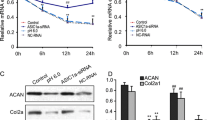Abstract
Acid-sensing ion channels (ASICs) are cationic channels that are activated by extracellular acidification and implicated in pain perception, ischemic stroke, mechanosensation, learning, and memory. It has been shown that ASIC1a is an extracellular pH sensor in the central and peripheral nervous systems, but its physiological and pathological roles in non-neural cells are poorly understood. We demonstrated a novel physiological function of ASIC1a in rat articular chondrocytes. The expression of ASIC1a mRNA and protein in rat articular chondrocytes was evaluated by reverse transcriptase polymerase chain reaction (RT-PCR) and Western blotting. The distribution of ASIC1a protein located in articular chondrocytes was determined by using immunofluorescence cell staining. The possible molecular mechanisms of articular chondrocytes pH sensing, as assessed by recording intracellular calcium ([Ca2+]i) in chondrocytes, were analyzed by using the laser scanning confocal microscopy technique. The cell injure following acid exposure was analyzed with lactate dehydrogenase release assay and electron microscopy. mRNA and protein expression showed that ASIC1a was expressed abundantly in these cells. In cultured chondrocytes, extracellular pH 6.0 increased intracellular calcium in the presence of extracellular Ca2+. The ASIC1a-specific blocker PcTX venom significantly reduced this increase in [Ca2+]i, and inhibited acid-induced articular chondrocyte injury. However, the increase in [Ca2+]i and articular chondrocyte injury were not observed in the absence of extracellular Ca2+. These findings show that increased [Ca2+]i, mediated via ASIC1a, might contribute to acidosis-induced articular chondrocyte injury.




Similar content being viewed by others
References
Weng XC, Zheng JQ, Gai XD, Li J, Xiao WB (2004) Two types of acid-sensing ion channel currents in rat hippocampal neurons. Neurosci Res 50(4):493–499
Waldmann R, Champigny G, Bassilana F, Heurteaux C, Lazdunski M (1997) A proton-gated cation channel involved in acid-sensing. Nature 386:173–177
Yermolaieva O, Leonard AS, Schnizler MK, Abboud FM, Welsh MJ (2004) Extracellular acidosis increases neuronal cell calcium by activating acid-sensing ion channel 1a. Proc Natl Acad Sci USA 101:6752–6757
Ye JH, Gao J, Wu YN, Hu YJ, Zhang CP, Xu TL (2007) Identification of acid-sensing ion channels in adenoid cystic carcinomas. Biochem Biophys Res Commun 355:986–992
Idowu BD, Knight MM, Bader DL, Lee DA (2000) Confocal analysis of cytoskeletal organisation within isolated chondrocyte sub-populations cultured in agarose. Histochem J 32:165–174
Lee DA, Frean SP, Lees P, Bader DL (1998) Dynamic mechanical compression influences nitric oxide production by articular chondrocytes seeded in agarose. Biochem Biophys Res Commun 251:580–585
Berridge MJ, Bootman MD, Lipp P (1998) Calcium—a life and death signal. Nature 395:645–648
Berridge MJ (1997) The AM and FM of calcium signalling. Nature 386:759–760
Huser CA, Davies ME (2007) Calcium signaling leads to mitochondrial depolarization in impact-induced chondrocyte death in equine articular cartilage explants. Arthritis Rheum 56:2322–2334
Jahr H, van Driel M, van Osch GJ, Weinans H, van Leeuwen JP (2005) Identification of acid-sensing ion channels in bone. Biochem Biophys Res Commun 337:349–354
Ponce A (2006) Expression of voltage dependent potassium currents in freshly dissociated rat articular chondrocytes. Cell Physiol Biochem 18:35–46
Yao H, Haddad GG (2004) Calcium and pH homeostasis in neurons during hypoxia and ischemia. Cell Calcium 36:247–255
Bonnans C, Fukunaga K, Levy MA, Levy BD (2006) Lipoxin A(4) regulates bronchial epithelial cell responses to acid injury. Am J Pathol 168:1064–1072
Lingueglia E, Deval ELazdunski M (2006) FMRFamide-gated sodium channel and ASIC channels: a new class of ionotropic receptors for FMRFamide and related peptides. Peptides 27:1138–1152
Price MP, McIlwrath SL, Xie J, Cheng C, Qiao J, Tarr DE et al (2001) The DRASIC cation channel contributes to the detection of cutaneous touch and acid stimuli in mice. Neuron 32:1071–1083
Ugawa S, Minami Y, Guo W, Saishin Y, Takatsuji K, Yamamoto T et al (1998) Receptor that leaves a sour taste in the mouth. Nature 395:555–556
Xu TL, Duan B (2009) Calcium-permeable acid-sensing ion channel in nociceptive plasticity: a new target for pain control. Prog Neurobiol 87:171–180
Mathy-Hartert M, Martin G, Devel P, Deby-Dupont G, Pujol JP, Reginster JY et al (2003) Reactive oxygen species downregulate the expression of pro-inflammatory genes by human chondrocytes. Inflamm Res 52:111–118
Browning JA, Wilkins RJ (2004) Mechanisms contributing to intracellular pH homeostasis in an immortalised human chondrocyte cell line. Comp Biochem Physiol A 137:409–418
Razaq S, Wilkins RJ, Urban JP (2003) The effect of extracellular pH on matrix turnover by cells of the bovine nucleus pulposus. Eur Spine J 12:341–349
Swain LD, Schwartz Z, Caulfield K, Brooks BP, Boyan BD (1993) Nongenomic regulation of chondrocyte membrane fluidity by 1,25-(OH)2D3 and 24,25-(OH)2D3 is dependent on cell maturation. Bone 14:609–617
Jasti J, Furukawa H, Gonzales EB, Gouaux E (2007) Structure of acid-sensing ion channel 1 at 1.9 A resolution and low pH. Nature 449:316–323
Hesselager M, Timmermann DB, Ahring PK (2004) pH dependency and desensitization kinetics of heterologously expressed combinations of acid-sensing ion channel subunits. J Biol Chem 279:11006–11015
Acknowledgment
This study was supported by the China National Science Foundation grants No. 30901526 and No. 30873080.
Author information
Authors and Affiliations
Corresponding author
Rights and permissions
About this article
Cite this article
Yuan, FL., Chen, FH., Lu, WG. et al. Acid-sensing ion channel 1a mediates acid-induced increases in intracellular calcium in rat articular chondrocytes. Mol Cell Biochem 340, 153–159 (2010). https://doi.org/10.1007/s11010-010-0412-y
Received:
Accepted:
Published:
Issue Date:
DOI: https://doi.org/10.1007/s11010-010-0412-y




